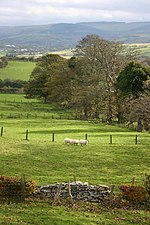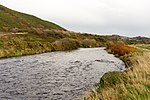Caradog Falls Halt railway station
Caradog Falls Halt railway station was one of five new halts on the Carmarthen to Aberystwyth Line (originally called the Manchester and Milford Railway before being transferred to the GWR), which were constructed during the 1930s. The halt opened in September 1932 to serve the nearby hamlet of Tynygraig, where a short tunnel ran underneath the road. It was also intended for the convenience of any visitors to the waterfalls. The halt consisted of a timber platform and corrugated iron shelter. The station closed in December 1964 when services were truncated at Strata Florida, following flood damage to the line at Llanilar. Formal closure was confirmed two months later. No trace of the timber halt remains, and the site is now in use as a private garden.
Excerpt from the Wikipedia article Caradog Falls Halt railway station (License: CC BY-SA 3.0, Authors).Caradog Falls Halt railway station
B4340,
Geographical coordinates (GPS) Address External links Nearby Places Show on map
Geographical coordinates (GPS)
| Latitude | Longitude |
|---|---|
| N 52.30815 ° | E -3.92113 ° |
Address
Caradog Falls
B4340
SY25 6AE , Ystrad Meurig
Wales, United Kingdom
Open on Google Maps





